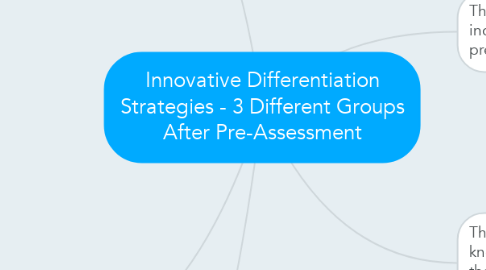Innovative Differentiation Strategies - 3 Different Groups After Pre-Assessment
da Emily Youngblood

1. The 5 students who appear to have limited knowledge about the topic.
1.1. Strategy 1: Class will begin with a lesson at a level appropriate for students with limited knowledge on the topic, for the 5 students who answered most of the questions correctly, they must answer a few warm-up questions to essentially skill out for this lesson and then may work on their project. The 5 students who have limited knowledge on topic will be able to have a full lesson on each topic.
1.2. Strategy 2: Provide Scaffolding
1.2.1. Model First
1.2.2. Think Aloud
1.2.3. Time to discuss with students who have knowledge on topic
1.2.4. Visuals
1.2.5. Hands on Activities (such as apples and oranges are the same fruit aka like terms, when we count how many apples we have and how many oranges we have we cannot mix up the fruit. This is like like-terms, etc.)
1.2.6. Graphic Organizers
2. Resources: "6 Scaffolding Strategies to Use With Your Students." Edutopia. N.p., 2011. Web. 08 June 2016. "Renaissance Teacher Work Samples Consortium." Exemplars. N.p., n.d. Web. 08 June 2016.
3. Assessments to track students learning throughout the unit
3.1. Pre-Assessment
3.2. Interim assessments for each objective (basically unit tests found in curriculum modified based on student needs)
3.3. Post-Assessment (end of chapter test from curriculum modified based on student needs which should include at least the original 8 questions with slight variations)
4. The 5 students who answered most, including the most difficult, of the pre-assessment questions correctly.
4.1. Strategy 1: Use Project-Based Learning (collect information on interests and create a project that interests the students)
4.2. Strategy 2: Provide more difficult problems that include higher order thinking skills
4.3. Strategy 3: Flip the classroom so that the lesson is given as homework and the work and projects are performed in class
5. The 12 students who have some knowledge about the topic as shown in their score, but need to develop higher order thinking skills.
5.1. Note: Likely answered problems about definitions and inverse operations but maybe couldn’t use these skills to actually simplify/solve
5.2. Strategy 1: Develop strategies to solve word problems (collect information on interests and create word problems that interests the students)
5.3. Strategy 2: Adjust difficulty (not as difficult as students already knowledgeable on topic) but maintain complexity of problems


